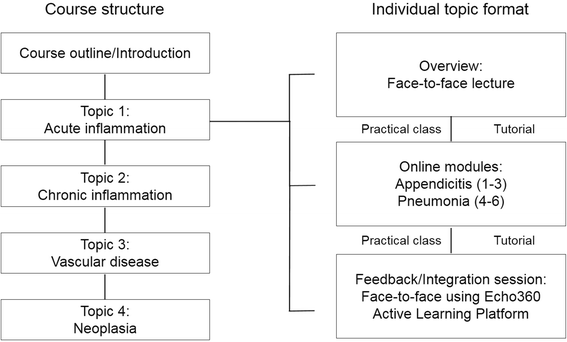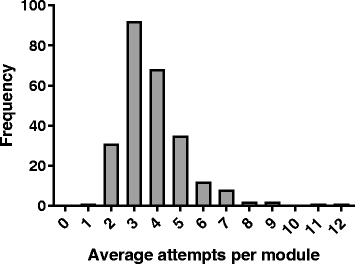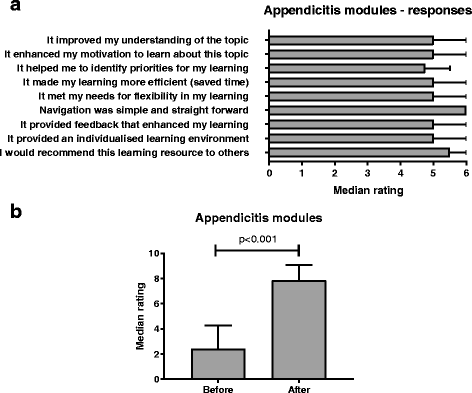A model for the use of blended learning in large group teaching sessions
- PMID: 29121908
- PMCID: PMC5680783
- DOI: 10.1186/s12909-017-1057-2
A model for the use of blended learning in large group teaching sessions
Abstract
Background: Although blended learning has the potential to enhance the student experience, both in terms of engagement and flexibility, it can be difficult to effectively restructure existing courses. To achieve these goals for an introductory Pathology course, offered to more than 250 undergraduate students at UNSW Sydney, we devised a novel approach.
Methods: For each topic presented over 2-3 weeks, a single face-to-face overview lecture was retained. The remaining content that had previously been delivered as conventional lectures was converted into short (12-18 min) online modules. These were based on lecture slides with added animations/highlights, plus narration using edited excerpts of previous lecture recordings. The modules also incorporated interactive questions and review quizzes with feedback which used various question types. Modules were developed in PowerPoint and iSpring and uploaded to Moodle as SCORM packages. Each topic concluded with an interactive large-group session focussing on integration of the content, with in-class questions to which students could respond via the Echo360 Active Learning Platform (ALP). Overall, more than 50% of face-to-face lecture time was replaced by online modules and interactive large-group sessions. Quantitative evaluation data included usage statistics from 264 students and feedback via online survey responses from 41 students. Qualitative evaluation data consisted of reflective commentaries from 160 student ePortfolios, which were analysed to identify factors affecting learning benefits and user acceptability.
Results: All of the modules were completed by 74% of students and on average, 83.1% of students eventually passed the optional review quizzes. Notably, 88.4% of students responded to in-class questions during the integration and feedback sessions via the ALP. Student reflections emphasised that the modules promoted understanding, which was reinforced through active learning. The modules were described as enjoyable, motivating and were appreciated for their flexibility, which enabled students to work at their own pace.
Conclusions: In transforming this introductory Pathology course, we have demonstrated a model for the use of blended learning in large group teaching sessions, which achieved high levels of completion, satisfaction and value for learning.
Keywords: Blended learning; Flipped classroom; Higher education; Large-group teaching; Online learning.
Conflict of interest statement
Ethics approval and consent to participate
The study and surveys were reviewed and approved by the UNSW Human Research Ethics committee (HC15134/HC16636). All students were provided with Participation Information Statements outlining that participation in the study was voluntary. Informed written consent was obtained from participants prior to the collection of feedback and survey data.
Consent for publication
Not applicable.
Competing interests
The authors declare that they have no competing interests.
Publisher’s Note
Springer Nature remains neutral with regard to jurisdictional claims in published maps and institutional affiliations.
Figures





References
-
- Picciano A. Blended learning: implications for growth and access. JALN. 2009;10(3):95–102.
-
- Francis R, Shannon SJ. Engaging with blended learning to improve students’ learning outcomes. EJEE. 2013;38(4):359–369. doi: 10.1080/03043797.2013.766679. - DOI
-
- Twigg CA. Improving learning and reducing costs: new models for online learning. In: Educause review. 2003. pp. 28–38.
-
- Alebaikan R, Troudi S. Blended learning in Saudi universities: challenges and perspectives. Research in Learning Technology. 2010;18(1):49–59. doi: 10.1080/09687761003657614. - DOI
MeSH terms
LinkOut - more resources
Full Text Sources
Other Literature Sources

